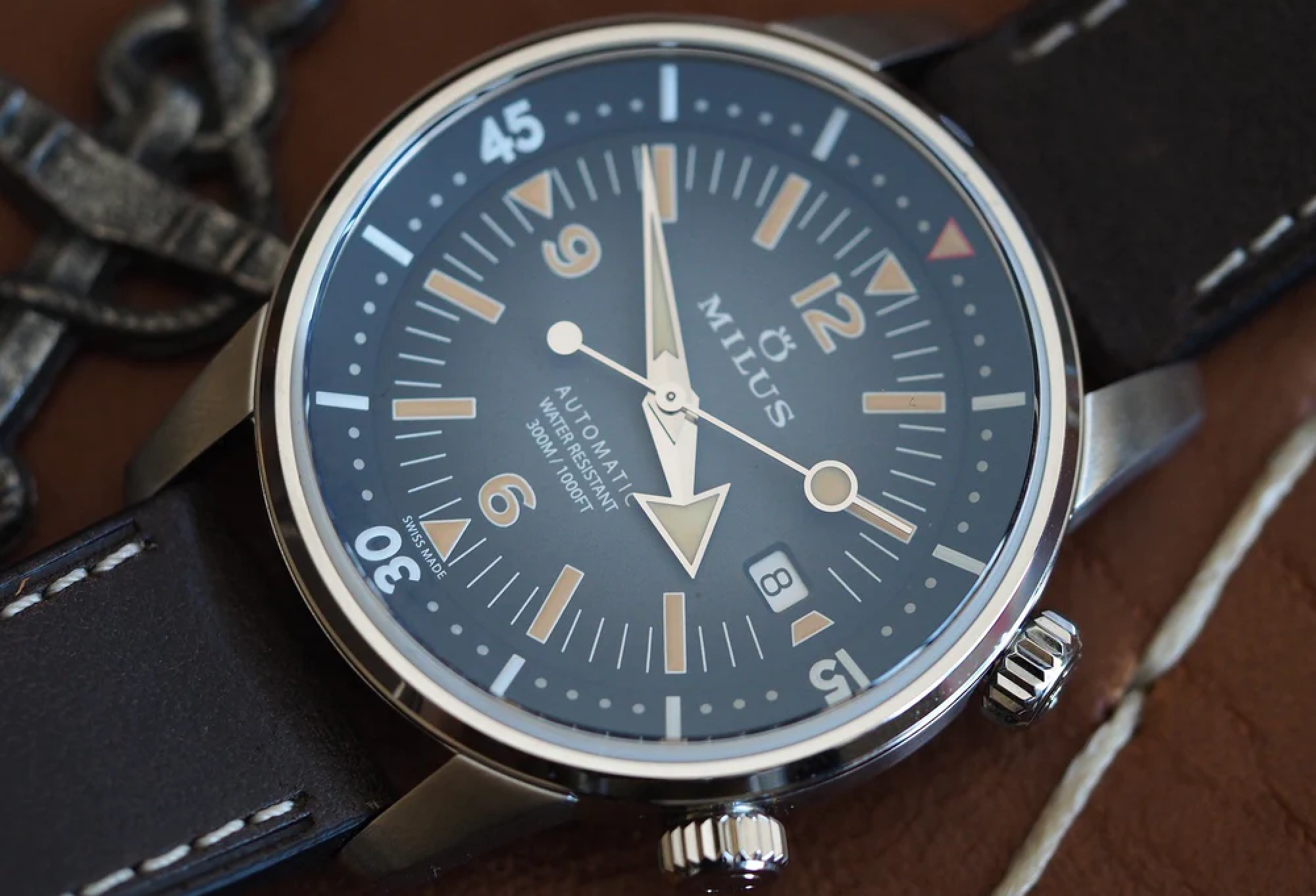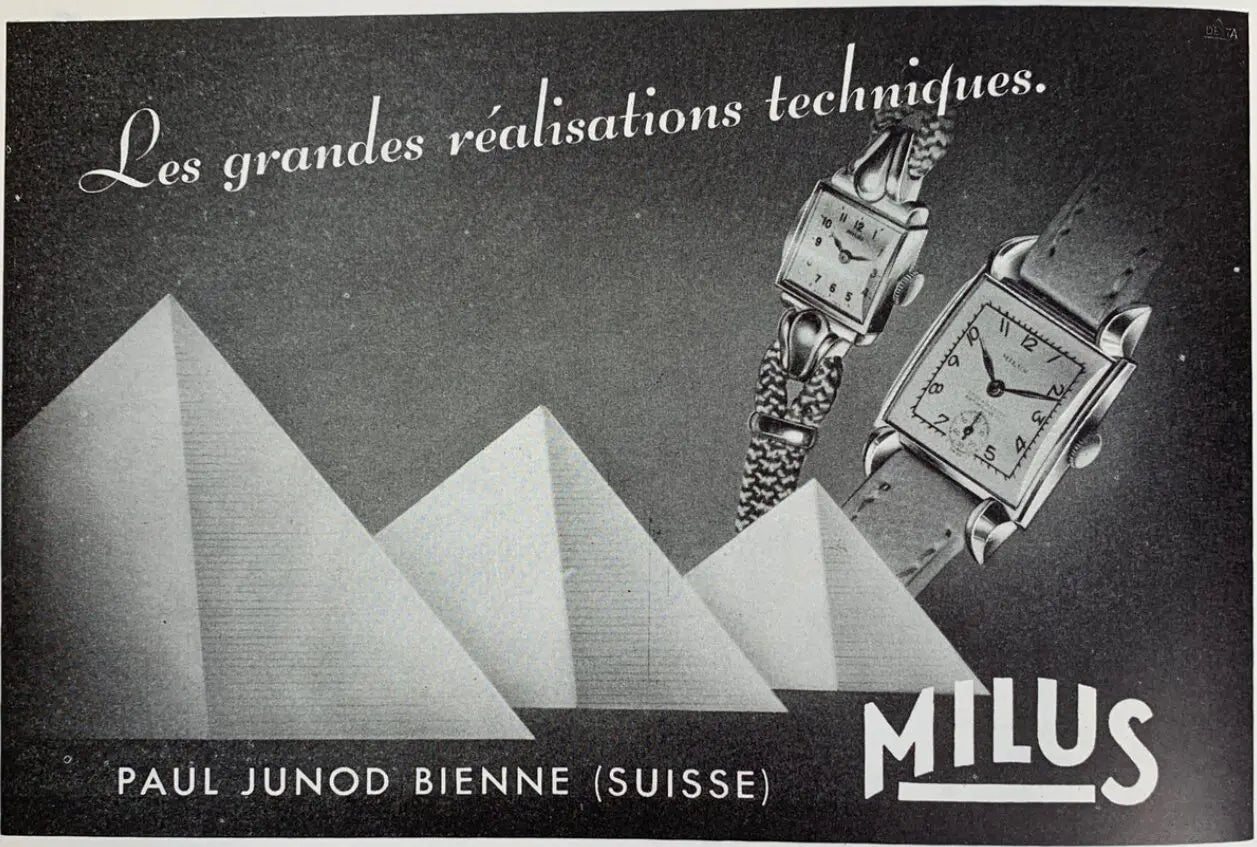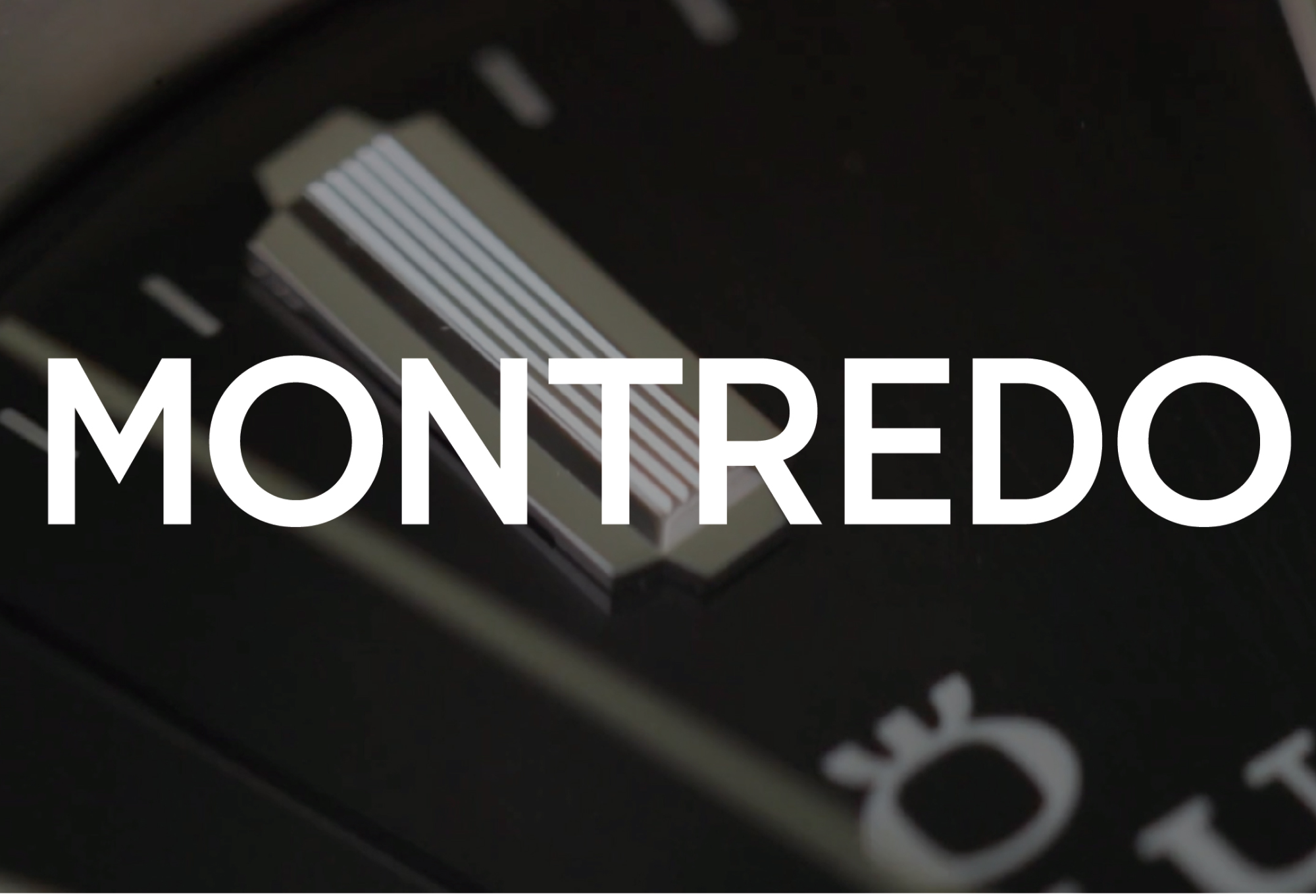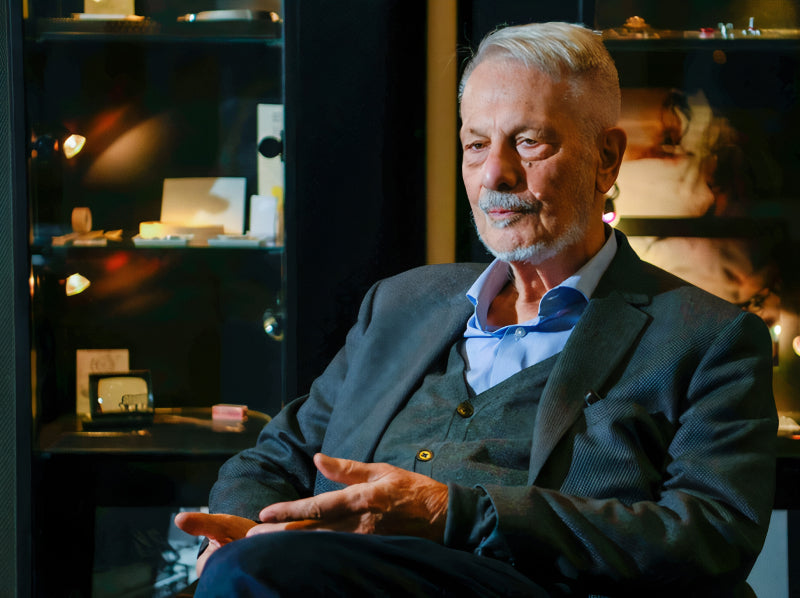
Luc Tissot recounts 60 Years of Watchmaking Between Crises and Challenges
This article has been freely translated from the original French version of LUC-OLIVIER.ERARD @ARCINFO.CH

He receives us not far from the Le Locle tower, which still bears his name, at the headquarters of the Tissot Foundation he created. At the age of 83, Luc Tissot is a passionate witness to the history of the watchmaking industry in the Neuchâtel mountains. A history intimately linked to his own journey, as winding as the Paraná River.
Indeed, it all began in Argentina... “I was born in Buenos Aires, where my father worked for an electricity company. I lived there until I was twelve years old and I have wonderful memories of it. I remain binational Swiss and Argentinean.”
In 1951, the death of his uncle Paul Tissot, then director of Omega and Tissot, precipitated the family's return to Switzerland. He studied in Geneva, then in Neuchâtel and graduated in La Chaux-de-Fonds.
“Part of my family wanted me to go on to train as a watchmaker. I wanted to undertake more advanced studies. My parents agreed with my ideas. In 1962, I obtained a degree in mechanical engineering from the Swiss Federal Institute of Technology in Zurich and an MBA from the IMD in Lausanne in 1965.”
“I could have settled anywhere in the world, but I chose Le Locle out of family tradition. I joined the factory.” So far as taking over the reins in 1981.
The 1960s: A rich heritage
From its beginnings, the watchmaking workshop founded in Le Locle in 1853 by Charles-Félicien Tissot (1804-1873) and his son Charles-Emile (1830-1910) was able to adapt to the needs of the time.
An historical production method of Swiss watchmaking, établissage consists in having watch components manufactured by small decentralized units, for example by peasant families. After assembly, the watches are entrusted to sales structures.
But at the end of the 1870s, mainly under pressure from American competition, industrialization began in Switzerland.
This is what historian Pierre-Yves Donzé (author of “Histoire de l'industrie horlogère suisse, XIX-XXe siècle” published by Alphil) calls the “Philadelphia shock”: during the 1876 Universal Exhibition in this Pennsylvanian city, Swiss watchmakers became aware of the need to modernize their production methods. The factories gradually replaced établissage, to take advantage of mechanization.
At the turn of the 20th century, the Americans introduced customs duties to protect their industry. The Tissot family reacted by sending their watches to the land of the tsars, until the Russian revolution. “We had to leave then. But my family kept links with Russia. I have an aunt whose mother was Russian.”
In the 1930s, the Tissot family joined forces with the Brandt family, owners of Omega, in a holding company, the Swiss Society for the Watch Industry (SSIH).
“This made it possible to divide up production. But the objective of this alliance was mainly commercial: to make a luxury watch, Omega, most models of which are sold at around 1,000 francs, and to occupy the segment of so-called ‘civilian’ watches with Tissot. They were about 30% cheaper than an Omega. Such an assortment allowed us to occupy a lot of space on the retailer's shelves.”
This distribution of the market will enable the brands to overcome several crises. The SSIH was already about 30 years old when Luc Tissot took off in the 1960s. “My father, Edouard-Louis, had introduced the unique caliber [ed.: a watch movement] for the four main models in our range. Sales had increased sevenfold in just a few years. The company gradually employed more than 1,000 people. My father was its CEO. I was production manager.”
In 1965, the current buildings of the Tissot company had to be built. “After examining the construction plans for the North Wing, the Le Locle Municipal Council had asked for two more floors to be added to the building, as this would embellish the city, according to them.” This request was granted. The period is prosperous. “It was amazing. We helped each other within the holding company, which had no debts. The construction of the Tissot buildings was financed by loans from Omega.”
1962-1971: The emergence of the synthetic
Leaders are confident. They have already started several years back several innovation projects. In particular, Edouard- Louis Tissot is behind the introduction of synthetic materials in watchmaking.
Around 1953, the first effort in this direction was the introduction of the self-lubricating bearing. Rubies, traditionally used in watchmaking to hold the gears of the movement in place, are expensive and need to be oiled for the movement to work perfectly. By replacing natural stones with this synthetic device, it is hoped to create cheaper movements.
At the time, innovation was not considered as formally as it is today, explains Luc Tissot: “We had problems, and we used to look at other industries to pick up ideas and adapt them to our needs. That is what happened with the self-lubricating bearing: the power generation industry was already using plastics for moving parts, just much larger.”
“To do the same, we were in front of the need to develop machines capable of injecting plastic at very high pressure, because our molds are much smaller." It is partly these developments that will later allow a wider use of synthetic materials in the watch industry, such as for the Swatch for example.
"Tissot is then a veritable hotbed of creation. We were faced with many obstacles, and we were also lucky. With the nylon used initially, the bearings were deforming too quickly. The gears were then housed in an oval, which disrupted the operation of the watches. Delrin, a much harder nylon derivative, came along, and we were able to overcome this problem."
Gradually, Tissot succeeds in making many precise components out of synthetic material, up to a complete movement and a box. In 1971, the Astrolon was launched, the world's first plastic watch without oil, which never goes out of order.
The very special design by Lucien Gurtner and the translucent case give a glimpse of the plastic gears. An aesthetic choice that Luc Tissot claims: "Of course! We wanted to show that making these pieces was an achievement." Commercially, the Astrolon was a failure: "The nylon derivative we used did not have the prestige of noble metals. We were told, 'Why make watches out of the same material as stockings?' It was also too expensive, and we didn't have the commercial power at the time to make a cheap product".
The 1970's: Quartz becomes essential, the crisis breaks out
In 1969, the first quartz watches of the CEH would indeed turn out to be the most precise in the world. "But the Japanese watch factories, which were more industrialized at the time, seized this new possibility with a completely different idea than ours: that of low-cost watches.
They quickly flooded the market. It was a tragedy," recalls Luc Tissot.
"SSIH continued to work with quartz for Omega, but at Tissot there was no more work. The company phased out production and concentrated on assembly. It was necessary to cut back." These are difficult times. "Up until then, the company was a bit paternalistic. For Christmas, for an hour or two, there were candles in the workshop. We also celebrated work anniversaries; we had built housing for the employees. During the watchmaking crisis between the mid-1970s and the mid- 1980s, many companies disappeared or, at best, fell into the hands of the banks."
"Between 1974 and 1982, SSIH saw its sales decrease from 12.4 to 1.9 million units," says historian Pierre-Yves Donzé. The vulnerability of Swiss watchmaking companies to foreign competition can be explained, according to the historian, by "poorly rationalized industrial management" and "a mismatch between products and the market," particularly because they are too expensive.
The 1980s and 1990s: Restructuring and diversification
Banks are forced to inject large sums of money into companies, including the SSIH, and call on the consultant Nicolas G. Hayek to carry out restructurings.
"The SSIH will finally join another holding company, ASUAG (Allgemeine Schweizerische Uhrenindustrie AG), to form what Nicolas G. Hayek will remarkably group together in 1983 under the banner of the SMH (today's Swatch Group)," explains Luc Tissot.
Under the signature of Pierre- Yves Donzé, history must remember that, once at the head of the SMH, after having acquired the majority of the capital in 1985, Nicolas G. Hayek "implemented an innovative industrial policy that contributed greatly to the rebirth of the Swiss watch industry."
From the beginning of the crisis, in the mid-1970s, Luc Tissot chose a different path. That of putting watchmaking techniques at the service of other industries.
"We had the idea of developing a device to measure blood pressure. I was introduced to Branco Weiss, director of Kontron, a subsidiary of the pharmaceutical group Hofmann-La Roche. He said: 'I'm not interested at all! What I want is a pacemaker.'" There are about 20 manufacturers of this implantable device that regulates the heart rhythm. But Hofmann-La Roche is trying to seduce cardiologists with a Swiss Made quality product made by watchmakers.
"When I presented our project to him, my father was dying. But he approved. He said, 'This is where we have to go. The authorities of Le Locle were happy, since we were hiring people."
"On the other hand, the SSIH board of directors said no. I was told, 'It has nothing to do with what we do. Moreover, watchmakers generally do not diversify their activities."
"In 1977, Hoffman-La Roche offered me the opportunity to become a shareholder in the new company Precimed instead of SSIH. It took us only one year from the foundation of the company to bring the product on the market, thanks in particular to the Dutch engineer Jerry Boer, whom we brought to Neuchâtel and who still lives there today."
Taken over three years later by the American company Intermedics, then by Sulzer, the activity of Precimed (editor: which has no link with the Precimed company existing today) will then be bought by the pacemaker manufacturer Guidant which closed the site in 1999. The staff will be laid off.
Another medical project marks the path of Luc Tissot.
"One day, Professor Salomon Hakim, a Colombian neurosurgeon, contacted me from Bogotá about an implantable valve to regulate brain pressure". Thanks to engineer Jean-Jacques Desaules and micromechanic Jean-Marie Delaye, Luc Tissot's team equipped it with a magnetic device that allows adjustment through the skin. Thus Medos was created in 1983. In 1991, the acquisition of Medos brought the Medtech giant Johnson & Johnson to the canton of Neuchâtel, an important milestone in the diversification of the Neuchâtel economy. The American group would eventually employ more than 1,000 people in Le Locle and Neuchâtel.
Thanks to the Tissot Economic Foundation Luc Tissot has created a third company, Tissot Medical Research, which is developing a contact lens that measures the intraocular pressure peaks that can cause glaucoma.
The years 2000 and 2010: The reign of the big groups
The 2000s confirmed the Swatch Group's domination of the watchmaking landscape, with the brands Omega, Tissot, Longines, Rado, Mido and, of course, Swatch, launched in 1983. The success of the Swatch made it possible to develop the Group. "The profits from the Swatch are also reinvested in the purchase of companies to enable the group to be present in all market segments," writes Pierre-Yves Donzé. The Biel-based giant Breguet, Blancpain and others will join the group in the coming years.
But Swatch Group is not alone in carrying out industrial restructuring in the Mountains. The Richemont Group was created in 1988 to diversify the activities of the family owning BAT (British American Tobacco) into luxury goods. Before 2000, Baume et Mercier, Piaget and Vacheron- Constantin joined the group. At the beginning of the century, the French group LVMH acquired TAG Heuer, Zenith and Hublot.
At that time, the sector experienced a strong trend towards vertical concentration, which saw many subcontractors come under the control of the brands.
As for Luc Tissot, he will return to watchmaking, but much more recently. Again thanks to personal relationships, maintained all over the world: "A friend I met 40 years ago during a research project in Houston (Texas), the famous scientist and artist Professor Dominic Mam-Kit Lam, connected me with the Chinese owners of Milus, They didn't know what to do with it. I took it over, and we are now working on reviving it by making quality watches at a fair price. I want us to return to the original spirit of the house. The watch is not just technology, it's something else. You wear it on your body, it closely represents the personality of the wearer. It is this personal link that is the hallmark of the mechanical watch."





